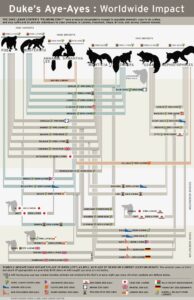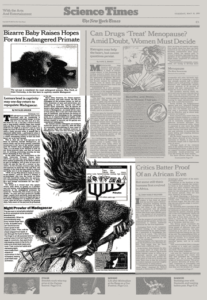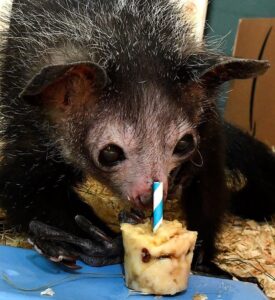Endora: A lemur, a legend
While many visitors to the Duke Lemur Center are familiar with well-known species like the ring-tailed lemur, very few of them have heard of the aye-aye, and even fewer have seen one in person. For the past several years, tour guests have entered the dim, red-hued quiet of the nocturnal building to come face to face with their first aye-aye: Endora. While Endora has lived on the tour path for many years, serving as a representative for the DLC aye-aye colony, her contributions to aye-aye conservation go much further than stealing the hearts of DLC visitors.

Endora is a visitor favorite at the DLC. Here you can see her unique front teeth and tapping fingers. Photo courtesy of Joel Sartore as part of his Photo Ark series.
Endora’s history at the DLC starts in Madagascar, the only place on earth where aye-ayes live in the wild. In 1991, the DLC was in the midst of a project to establish breeding populations of endangered lemur species as a genetic safety net. As aye-ayes were (and still are) incredibly rare to find, three separate missions were conducted to collect breeding animals from the wild to ensure a viable breeding population at the DLC. By the final mission in 1991, the DLC was home to eight wild-caught aye-ayes who would be the forefathers (and mothers) of the first conservation breeding program for aye-ayes in the United States.

The DLC houses the largest colony of aye-ayes in the world, thanks to Endora and the rest of the “Founding Eight.” Descendants can now be found throughout the USA and around the world.
Since this population was one of the first of its kind to be kept in human care, the finer points of aye-aye husbandry were as yet unknown. While aye-ayes were known to eat insect larvae in the wild, it took quite a bit of trial and error to land on the perfect combination of menu items to appease even the pickiest individual, while maintaining the best possible nutritional health. With highly specialized teeth and tapping fingers, the DLC’s first aye-aye population were full of surprises, allowing the staff to learn more about these rare primates than ever before.
But no surprise was quite as wonderful as Endora’s. Unknown to the wild-capture team, Endora had arrived at the Duke Lemur Center in 1991 already pregnant with what would be the world’s first captive-born aye-aye: Blue Devil. Blue Devil was discovered in Endora’s nest in 1992, and quickly became famous. Endora’s enduring legacy was also born, right along with Blue Devil. Since Blue Devil, Endora has gifted the world with five additional offspring, most of whom have gone on to have their own children. Currently, there are over twenty aye-ayes living in zoos across the United States, as well as additional aye-ayes in London, Frankfurt, Tokyo, Taiwan, Bristol, and the Jersey Channel Islands. The DLC still boasts the largest aye-aye population with ten individuals.

The article from the New York Times announcing the birth of Blue Devil.
Since so little was known about aye-ayes in 1991, it is unclear how old Endora was when she came to the DLC, and thus our best guess as to how old she is today. Since she was old enough to be sexually mature in 1991, our estimate brings Endora to about 37 years old! As far as we know, this is the oldest aye-aye ever recorded. As these wonderful and mysterious animals have aged, the veterinary and keeper staff at the DLC have continued to learn how best to care for an aye-aye, through all the years of its life.
Aye-ayes rely heavily on their tooth and finger adaptations to find food. The constant wear from chewing through hard wood is usually enough to keep their ever-growing incisors in check, but as they age, those teeth aren’t as tough as they used to be, and may be in danger of growing too long. Endora, among others, gets her teeth trimmed on a regular basis. To care for those aging teeth, the keepers add softer, decaying logs full of squishy bugs and other soft foods. Regular check-ups and plenty of observation are also key to making sure that our most ancient aye-aye is still feeling young.

Endora receives a birthday treat from her keeper team.
While years of diligent observations from the DLC care team have enabled Endora to be the conservation superstar she is today, the more casual observations from the general public are just as important to Endora’s legacy. The excitement and wonder that guests experience when meeting not only their first aye-aye, but such a legendary one, is a palpable part of inspiring critical conservation work. While we hope that Endora’s relatives in Madagascar are thriving in the hidden shadows of the forest, it is Endora’s visibility and representation that forges the connection so crucial to saving the species. When she approaches the door, props herself up on her long-fingered hands to get a closer look at a young child or excited student, it is a moment that those people will never forget. Endora’s contribution to aye-aye conservation in her prowess as a mother and her charisma on the tour path will live on into the future – as ageless as she is.

